Entries Tagged as 'Megan'
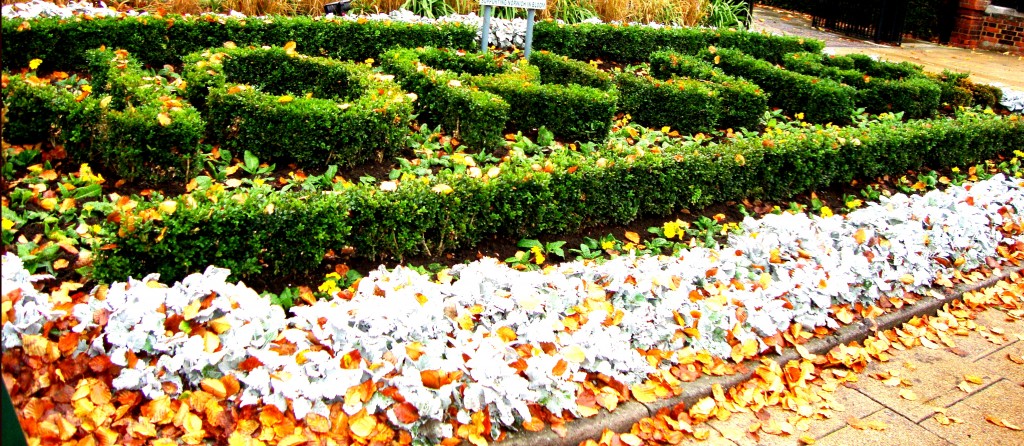
Before I came to Norwich, I expected it to be a small town with not much to offer a big city girl like me. As an English major and art minor, I have always been interested in the arts. But in New York, and even sometimes at Dickinson, arts events like small music gigs or poetry readings are all kept in a need-to-know or who-you-know circle. When I first arrived in Norwich one of the first few ‘local’ people I met was Stephanie Leal, one of our tours guides for the tour of Norwich. As a published poet, Stephanie told me and a few of my literary friends about the monthly poetry readings at the pub the Birdcage. I went to one of these within my first month here and loved it. As cliché as it sounds, I found being surround by so much creativity and talent really inspiring for my own artistic pursuits.
When it came time to choose something as my ‘Experience’ in Norwich, it wasn’t hard for me to pick out my interests. I knew the Birdcage was great and wanted to pursue the poetry/arts scene in Norwich. But it wasn’t until I began spending time researching and making connections here that I realized how huge the arts scene in Norwich really is. Now, you may be thinking, New York City must have a big arts scene, bigger than Norwich! And while that may be true, it’s hard to make connections with ‘local’ poets in New York. By the time most people get to New York, they are already up-and-coming. Tickets sell out fast, most of the good arts scene is underground, and you have to know how to look for it. And honestly I don’t. But in Norwich few events sell out too quickly and even well known successful poets, like the members of Aisle 16, have time to chat with a uni student like me.
Following the performing arts scene in Norwich led me to discover the Norwich Arts Centre, which holds concerts and various music shows as well as some art exhibits, and the live music at the Black Horse Pub during March. I also got to spend more time at the Birdcage readings. There were also more events and venues I just didn’t have the time to attend. There are various concerts held at the Waterfront and prose and poetry readings at Jurnet’s Bar Wensum Lodge from October to March as part of a series called Café Writers. Art is bursting from Norwich, all you have to do is look.
Besides attending all these great events, my project taught me to appreciate a lot more live music than I used to. I learned that artists of all kind are people who are accessible and want to share their experiences. Through my interview with Aisle 16 I found out about the differences between performance and printed poetry. Several of the members of Aisle 16 graduated from UEA. I began to realize that artists aren’t born out of a vacuum with the ability to create beautiful and moving works. Instead, artists are people who went to school, met up, shared passions, and created together. My exploration of Norwich arts help to inspire me in my own artistic endeavors. Here at UEA, back at Dickinson College, and at home in New York, opportunities are there, people are interested, and creativity can be found all around—even in a small town like Norwich.
Tags: Megan

Image Credit: http://www.thebirdcagenorwich.co.uk/Gallery.aspx
Image Credit: http://www.thebirdcagenorwich.co.uk/Gallery.aspx
This month’s Cabaret at the Birdcage, on 24 of March, was a little different from the past few I’ve attended. Since it fell over UEA’s Easter Holiday, the line up was mostly adults—and my flatmate, of course. The performance began with Christine York. What to say about Christine? Well, her opening piece was entitled, “Punk Rock Granny.” And that she was. To be honest, I was glad when her series of poems on elderly sex and proper table manners were over. She was followed by the debut reader Jill Dean, reading the work of her mother’s boyfriend, John Simms. Simms’ poems touched on poignant memories of love and family members. This brought the mood of the show back down to what I had expected. Following this was my flatmate, L. Eaves. Beginning with a new piece of his, “Gallows Humour,” which dealt with finding the humour, irony, and sadness of death. Then of course there was the old classic that all L. Eaves fans know and love, “Grumpy at 20,” which professes the desires of a grumpy 20-year-old not to party, drink, or enjoy loud frivolous activities.
After this the mood of the show changed yet again. How to describe what followed? Andy Sprag was due up next, but due to…something…he was unable to attend. In his absence he sent along a cassette tape to be played. The cassette tape blared at full volume, essentially white noise in the form of odd gospel-singing-stuff. No poetry. None of Andy’s singing. Just this bizarre white noise gospel like music. Next up was Adam with poems that twisted fairy tales, Megan Pervis (a fellow American, from California) who performed solemn more serious poetry, including a poem entitled, “Non Journey,” and comedienne Amy Nickelson with amusing thoughts on contraception. The finishing act was, yet again, something totally unexpected and mood changing. Will Averill took the stage and explained that he loved Irish folk music and gangsta rap. To further illustrate this point, Will performed his first poem in a mixture of folk and rap. He followed with his poem “Smurfette,” and closed with some audience participation. Which I hate. It consisted of some groups yelling, “THE POPE,” and others, “THE GAYS.” I think you get the picture.
Overall the eclectic line-up provided for a reasonable show. Not quite the level of performance usually found at the monthly Birdcage Poetry Cabaret, but still worth the single pound the show costs. I recommend these performances every time!
Hours: 2.5
Total: 12.5 (and done!)
Tags: Megan

Pete Lee
I know what you did last Friday: you went to the Black Horse pub on Earlham Road for March Madness. What’s March Madness? It’s not really that mad, it’s actually just live music every Friday. This past Friday, my flatmates and I attended this ‘live music’ that we saw advertised in the Outline Magazine. What went wrong?
To start with, there was no band. Instead, there was some guy’s 40-something birthday party. Then, there was his drunk friend who happened to know how to play acoustic guitar. That was this past Friday’s live music. After waiting for about an hour for the ‘performance’ to start, the birthday boy finally mounted ‘the stage’ to announce that his friends, Pete Lee, would be performing The La’s self titled album in its entirety. This wouldn’t have been so bad, since the album is a classic by the band which formed in 1983. However, good ol’ Pete sang too close to the microphone, blasting scratchy loud music across the otherwise calm atmosphere of the non-student pub. He also temporarily forgot how to play the most famous song, There She Goes. After watching him struggle with the opening chords of this song a few times, he finally got it right. The crowd clapped, sang, and drank along with Pete, raising the general mood. Even my flatmates and I, save the one who doesn’t sing along with other people’s songs, were able to enjoy this song.
Overall, I am sure that on other Fridays, when it is not a birthday gathering, the live music must be quite nice, since the Black Horse atmosphere suits an acoustic performance. It is littered with comfy chairs with a bookshelf (complete with old-looking books) lining one wall. Seems I just picked the wrong day to go!
Hours: 2
Total: 10
Tags: Megan
In the beginning, before WWI…there was Fionn Regan. My flatmates and I went to see Fionn Regan at the Norwich Arts Centre on February 25. The crowd, as my flatmate noted, was made up of mostly “artsy 20-somethings.” Regan has released two albums and five EPs. Unfamiliar with Regan ahead of time, I found it hard to distinguish the lyrics of his indie folk songs—especially with his Irish accent. The gig opened with the up and coming band Danny and the Champions of the World, who also acted as backup band for Regan later on. All the members of the Champions wore plaid shirts and were vaguely reminiscent of New York hipsters. My favorite by far was the drummer, who wore black thick rimmed glasses. Despite their lack of fan base in the audience, the crowd took to the band immediately. Their upbeat songs and catchy lyrics were easy for us to pick up. The addition of acoustic pieces along with these faster songs kept us all engaged. The Champions successfully built up the excitement for the main act: Fionn Regan.
When Regan finally took the stage, I have to say I was a little surprised. Also decked out in plaid, Regan wore a collarless shirt with a silver beaded necklace. He donned an old-school mushroom hair style and kept his mouth right on the microphone—adding to my inability to distinguish his words. However, his fans in the audience had no difficultly singing along—except my flatmate who apparently doesn’t sing at gigs. The crowd cheer at every one of Regan’s lyrics. And as one of his final songs, his best known single from 2006, Regan turned the mic off and let the crowd fill in the chorus, “Be good or be gone.” I have to admit, this last song did move me a little. I always enjoy being part of the crowd’s energy.
Overall, I wouldn’t say that I am a converted Fionn Regan fan, but Regan is just another example of the eclectic music scene in Norwich!
Hours: 2.5
Total Hours: 8
Tags: Megan
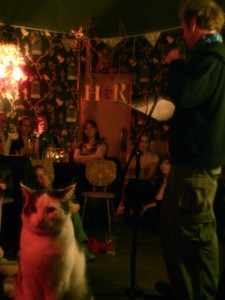
The Birdcage resident cat and Russell J. Turner hosting
Last week, I attended the every third Wednesday of the month poetry Cabaret, HEADCRASH, run by local poet, Russell Turner. It features other local poets in the small coffee shop atmosphere of The Birdcage Pub.
This month’s cabaret featured a phenomenal line-up. It began with the prose pieces by Cora Benzie, who began by offering the disclaimer that the male narrator of her pieces was not her. Normally prose performed drags on and is a bit hard to follow, but not this. Not only was it edgy and enthralling, but the short length and detailed narrative made it easy to follow. Next up was Roger the Zombie who seemed to do a stand-up comedy rant against everything… followed by John William Brown who read some poignant post Valentine’s Day poems. Unlike most poems of this holiday, these touched on the loss of loved ones and the love of family members. Then the host, Russell J. Turner stepped into the line-up to fill in a for a few people who couldn’t make it. He performed a piece inspired by words found on a random generator—the idea was credited to Tim Clare of Aisle 16, who I talked about in my past entry. After a short drink break, the show ended with two final acts: Stevie Watson and Hannah Jane Walker. Watson performed, among other pieces, a poem called, “Technology Scares Me.” She also had the most amazing English or something accent ever! Walker closed with a large group of poems ranging from pieces about apologies to all the things that you want to tell the person you care about, but instead you are a jerk.
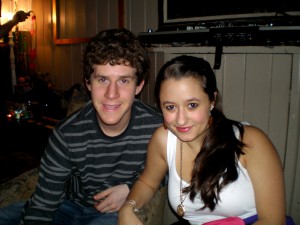
Andrew accompanied me and actually enjoyed poetry!
All in all, the line-up and performance was great. But the best thing about the whole event was not the performance, but the fact that I got to successfully introduce poetry to my friend, Andrew Barron. Thanks for coming Andrew, and I am so glad you had a good time! In the future, The Birdcage holds events every Wednesday, which rotate between music poetry, and comedy. I definitely recommend checking it out! It is only a pound to sit on couches and watch the show!
Hours: 2.5
Total Hours: 5.5
Tags: Megan
February 18th, 2010 · 1 Comment
Interview with John Osborne, member of Aisle 16**
On Monday night, at the Norwich Arts Centre, I got to play member of the press. Showing up for my interview with Aisle 16, I bought my ticket for the show and asked at the front desk where I could find the poetry group for their interview. They sent my name back, and I got escorted into the performance area not only for my interview, but o see a little tech setup behind the scenes action (pretty cool). There, I spent some time talking with John Osborne, of Aisle 16.
Since my arrival in Norwich I have noticed that there is a very accessible and large poetry scene here. Osborne gave several reasons he thought that Norwich was unique. The first is UEA, which brings a lot of good caliber writers to Norwich. The second is the Bird Cadge which opened in 2006 when Osborne was a student at UEA. While Osborne admitted, “I can’t really say how it’s different since I don’t know a lot of other areas,” he was willing to say, “it’s better than other areas and when people come to t he area they are impressed with it.”
In the history of Norwich and East Anglian poetry there is a long line of rural and agricultural poetry. But Aisle 16’s poetry, and the contemporary poetry in Norwich has moved significantly away from that. Osborne suggested that this is because poets write about what they know, what touches and influences them on a daily basis. For those poets, farming was central to their lives, but today that average person in East Anglia may never visit a farm.
I asked Osborne how Norwich and UEA influenced his experience with poetry. He admitted, “I really didn’t have any knowledge of poetry. I liked song lyrics but I had never heard of performance poetry until my time at UEA. I learned about performance poetry from my friends and people I met at UEA.” This is just another way that the contemporary Norwich poetry has changed from the time of Bloomfield and other historic East Anglian Poets. With the university there begins a learning process and collective exploration that was not there before.
In my studies of East Anglian poetry, and poetry in general, I have always been more familiar with the published and printed poetry rather than the spoken word poetry. When asked to comment on this Osborne suggested that performance poetry is a cross between stand-up comedy and poetry. There are some live poems he would never publish because they just don’t look good on paper. But when you hear them, they are brilliant. Others don’t sound as good, they might be really depressing and people just don’t want to hear that. You always have to keep in mind your audience. But hopefully a poet’s persona as a published poet and a performance poet is not too different. He offered an analogy to a vendiagram to explain this. One circle is you when you perform, the other is you when you write. The center overlap is your identity as poet. The bigger the center the better more successful poet you will be.

Osborne's vendiagram of poetry
When asked the classic chicken-egg question: what came first, the poetry or the theme of the show? Osborne explained that in this case the theme of ‘going home’ came first, and the poetry was written around that, but that that is not always the case. With the publication of Aisle 16 book, Live from the Hellfire Club, Osborne noted that they would still consider themselves a performance poetry over a written poetry group.
Finally, for all you aspiring poets out there, Osborne’s big piece of advice is to write everything down. Keep a notebook by your bed and write down all your ideas, even if they are just words or sentences. Because, as Osborne explains, the blank page can be hard to conquer and it is much easier to start with some old ideas.
**Please note that despite the use of quotations this post is a paraphrase of what was said during the interview with John Osborne
The Show: Local Boys Done Good
The show itself was fantastic. It combined both the spoken word of the poets and various videos and music which flashed and played on a large projector screen behind them. It opened with a piece on the awkward teenage years, by Tim Clare, which he performed at the UEA Grad Bar the week before. Then, Aisle 16 members Ross Sutherland, Joe Dunthorne, and Chris Hicks performed an interactive poem called, “Raise Your Status,” which, as the title suggests, offered various comical ways to raise your status. But both these acts served simply as an introduction to the real show.
After the break, Sutherland introduced the theme of the show by defining ‘home.’ He touched on Freud’s Beyond the Pleasure Principle, and used a circular diagram to describe the progression of the hero after he’staken away from home as he seeks to return home. However, Sutherland asked what would happen if suddenly the diagram was flipped, and home was on the dark uncertain side of the circle, and we were trying to escape home rather than return to it? I found this very moving, especially when he said, “Home is the place that knows us better than anywhere.”

The cycle of leaving and returning home
After this introduction each member of the group discussed their experiences performing in their hometowns, while a video clip played behind them. Each member also performed the piece they wrote for their hometown.
John Osborne, first performed his piece “Local Boys Done Good” in the town hall of his hometown in Brigg. Ross Sutherland wrote “When Paper Boys Roam The Earth” about his hometown Coggeshall Essex and performed it in the Chapel Pub there. Joe Dunthorne read his poem about the rough nature of the city Swansea in Wales where he grew up entitled, “Wild Wild West.” Chris Hicks grew up in Quarley, Hampshire. Unlike the performers before him, Hicks had a terrible time doing the show for his hometown and called it one of the “worst experiences of his life.” He performed two poems, “Monkstone Demands 20” about the neighboring town, and “Yesterday Reenactment Society.” And last but not least, the show closed with Tim Clare who explained his experience going home where he realized, “My hometown had done better than I had.” Because the town had done so well, the only venue he could book for him hometown show was the playhouse. And to close the show, Clare performed a touching song (which unfortunately I cannot find a video of) on a ukulele called, “Think of England.”
The show offered something for everyone: comedy, drinking, frustration, and a poignancy that forced us all to consider how our hometowns have shaped us, how as children we dreamt of getting far away, and how as adults we must eventually return and confront a place central to who we are.
Hours: 3
Total Hours: 3
Tags: Megan
February 1st, 2010 · 4 Comments
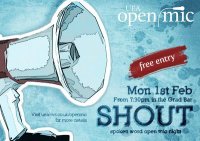
Today, at the UEA Grad Bar Creative Writing Society’s Open Mic Night, I met Tim Clare and John Osborne. I just went right up to them, and introduced myself, and asked if I could ‘have a chat with them’ and it was awesome. Right about now, you are probably wondering who these two guys are and why I am even bothering to tell you I met them, let alone bragging about going up and talking to them. Clare and Osborne are both members of the up-and-coming if not already up, poetry group known as AISLE16. And, if you are doing a big research paper/project on Norwich poetry, with an experiencal bit based on the contemporary poetry scene in Norwich, and you just happened to have discovered Aisle16 via the inter webs just a few nights ago, seen that they had a show in Norwich coming up, and hoped to get a chance to interview them—all of which has happened to me—and then magically, you’re in the Grad Bar listening to your peers then one of them gets up and performs, well you would be just as excited as I am right now to say, “Yeah, I went up and talked to them.”
But a little bit more on Aisle16. The Norwich Arts Centre (NAC) calls them, “the UK’s most sought-after poetry collective.” And this Monday, 8th February at the NAC they will be returning to their hometown of Norwich to perform a show about leaving home and then returning home (hopefully to receive some glory). Having now seen both Clare and Osborne, two of the five members of the group, perform live, I can say they are both comedic and touching, balancing satire with the most poignant sense of adolescent misplacement that we’ve all once felt. Before the show on Monday, I will be interviewing the members (YIKES!) as part of the experience elements of my poetry research project. So keep an eye out for Hometown Glory Part 2: The Interview.
Tags: Megan
September 30th, 2009 · 1 Comment
Well hello, family, friends, Qualls, and anyone else who chances to read this brief update on my days at uni.
Classes
Here at UEA I have each of my two UEA classes for two hours once a week, my Dickinson Humanities course once a week, and Art Society once a week for two hours. Here is a brief layout of my days:
Monday: Revisioning the Norwich School of Painters art history course, 1pm-4pm in town at the Castle Museum. We spend most of our time in the two main galleries, Crome and Cotman looking at the original works by the NSP and discussing the ‘genre’ of landscape art, its development, relevance, and current state. There are a total of eight students in this seminar course, and I am the ONLY international student, and the only student who was not in the course with these seven other students last term.
Wednesday: Cultural Theory and Analysis English literature course, 12pm-2pm in the main arts building. This course is about 15-20 students, all second year lit, philosophy, or art history majors. I am one of MANY Americans in the class. It seems like this course will look at various literary theorists (YAY!) and work towards answering the question, what is culture?
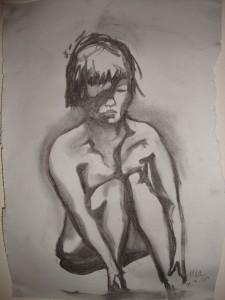
One of my still life drawings from Art Soc
Somewhere else during the week my 310 Dickinson Humanities course will meet for about two hours. And on various days Art Society (Art Soc) meets for two hours of open studio to work on various projects the club has set up. The first week we met we did telephone with drawing where two students drew the still life and the the rest of the students lined up behind them and drew another student’s drawing and so on and so on. After that we broke up into pairs and drew each others’ portraits. This week we was Life Drawing where we had a nude model. I worked with charcoal. She did various poses (which I thought could have been better) for increments of 5, 10, and 15 minutes while we all drew her.
Housing

Me after the Rubix Cube Social posing near The Village sign
I live in Courtyard A which is one of several dorm style buildings in University Village. My flat is a long hallway which branches off into a kitchen/common space, and six single bedrooms. I live with two other girls, and three other boys.
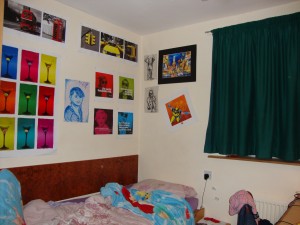
The bed nook of my room
There is one other international student in my flat and he is from Kazakhstan. I cook myself and several other of my friends dinner every night. We eat out very infrequently to save money. We get our stipends once a week and usually food shop that same day.
Town
Our program provides us with a year long bus pass. I take full advantage of that and ride the bus for about 20 minutes at least 4 times a week into the city center of town. There I can find several Starbucks, thank goodness, shopping malls, grocery stores, and various other cosmopolitain things.
Thus ends the update. Enjoy!
Tags: Megan
September 16th, 2009 · 2 Comments
What is there to say, really, that has not already been said? More than anything else I was told before coming here, I was told that pubs were ingrained into the English culture, often known as pub culture. Now having been to a pubs myself, including a few busts that were propagated largely by older men, I am still not sure that I can pin-point just what “pub culture” is. I guess in that way, pub culture is much like the British identity, elusive and complex.
However, there are a few keys things I can note about the drinking, or pub culture I have been so often encouraged to look out for. Perhaps I can sort out a little of the truth from the myth pub culture has really grown to be. Yes, it is true that English drink more, more often, and earlier than seems to be the practice in the US. At 4 o’clock in the afternoon, if you walk by a pub you will encounter a large crowd of people, often in business suits, standing outside the pub drinking. Another thing, people stand outside. Most pubs, perhaps for lack of standing or sitting room inside the pub, or maybe so people can smoke, or even just because they want fresh air, tend to have large crowds standing in front of the pub often under an awning. Yes it is true, people seem to be relatively friendly in these pubs, but, they still come with a group and tend to stay with a group.
This brings us to the bog winner question: do pubs and pub culture act as a window into the British culture? I would say more often than not, no. While pubs of course demonstrate the key difference between the late night drinking of America and the all day drinking of England, beyond that they illustrate little more. In my time spent there I have interacted with little to no “Brits” and found few pubs that even held my age group. Once we arrive at UEA, I look forward to see how this will change as we will more back into the college town setting we are used to in Carlisle. But even still, the mainly older crowds in pubs forces me to wonder, is pub culture a thing of the past. Are younger people simply going there and getting drunk and somehow closing the curtains on this “window” we Americans eagerly attempt to look through?
Tags: Megan · Pubs
September 15th, 2009 · 1 Comment
Today I visited the British Museum. Yes, I know, I am probably the LAST person to go there. But to be honest, I was really putting it off. Now that may seem strange to you, since if you’ve been keeping up with my blog, you know I ADORE museums. Yet, for some reason the idea of museum that I could spend my entire life trying to see the entire collection of, just didn’t get me going. I was told it was a history museum, told it was vast, told it was cool. But still. I’m not a history museum fan and I guess the past month has really museumed me out. With all that being said, I LOVED it.

Egypt Wing of museum
And I loved it for several different reasons. The first and less detailed reason was what I faced when I first ventured into a gallery. It was the Egypt wing. I am not a fan. I don’t dislike all the mummy cases and pharaoh busts, they just aren’t really my thing. But back in Brooklyn, at the Brooklyn Museum of Art, the museum that I have been going to since my stroller days, the first place where I took an art class, and where I spent my summer interning, there is a HUGE Egypt wing. And suddenly, there I was, middle of the British Museum Egypt wing, in London, in England, in a FOREIGN COUNTRY, and home, all at once. I didn’t stay in the wing long, but the small boost of Brooklyn love I got from the wing was just what I needed before we embark on our new adventure to Norwich.

The Greece Wing of the British Museum
Another reason I loved it was on the pure artistic level. As a museum lover and art minor, walking into the museum facing the Greek statues and really analyzing them art historically was so amazing. I really took my time looking a few pieces rather than trying to see everything in the overwhelming collection. I noted the realism in the Hellenistic section of the Greece wing. I got right up close to the statues and looked at the small details, the way the flesh was rolled where the body curved, or the controposto (weight distribution), or the way the head resting on the elbow really had the right weight. Even the way the lighting on the marble gave it a warm yellow hue, almost like the warmth of skin and the human body, making the figures see that much more alive and real. Often I found myself inching closer and closer to a figure wanting to touch the marble, wanting to feel the coolness of it just to remind myself it was not warm flesh.
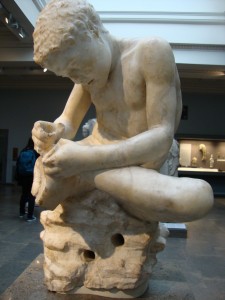
There was on statue of a small boy, Marble statues of a boy, the so-called ‘spinaro.’ This one was one of the most touching. The boy was pulling a torn out of his foot. And the expression on his face was just right, to show a little boy’s concentration and fascination. Having a little brother myself may have biased me towards this sculpture over others, and maybe it was just another thing in the museum that made me feel at home. But really, even the way to boy was crouched over suited the narrative of the piece.
On another note, the British Museum has so many connections to our course here in London. Aside from its fame Reading Room that relates to the literary history of this area, there is always the basic collection as a representation of all the different communities and cultures present. With a wing from almost every continent, the British Museum has very few things that could be considered wholly “British.” But at the same time, isn’t that really what we have learned here this past month, that NOTHING really is WHOLLY British? I think it is. In essence, the British museum encompasses our whole class and our final conclusion that there is no British identity. That there are only many pieces from many different elements of people’s lives that use to help with their personal identification.
Tags: Megan · Museums















